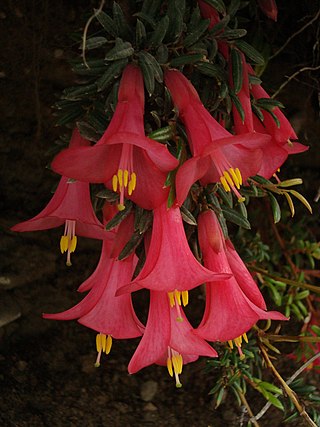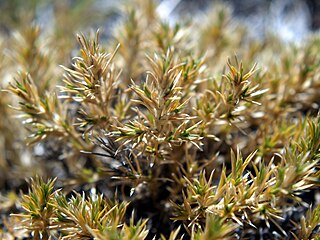
Jubaea is a genus of palms with one species, Jubaea chilensis, commonly known in English as the Chilean wine palm or Chile cocopalm, and palma chilena in Spanish. It is native to southwestern South America and is endemic to a small area of central Chile between 32°S and 35°S in southern Coquimbo, Valparaíso, Santiago, O'Higgins, and northern Maule regions.

Schoepfiaceae is a family of flowering plants recognized in the APG III system of 2009. The family was previously only recognized by few taxonomists; the plants in question usually being assigned to family Olacaceae and Santalaceae.

Philesia is a South American genus of flowering plants in the family Philesiaceae first described as a genus in 1789.

Olsynium is a genus of summer-dormant rhizomatous perennial flowering plants in the iris family Iridaceae, native to sunny hillsides in South America and western North America.

Delairea is a genus of flowering plants within the family Asteraceae. Currently, it only features two species: Delairea odorata from Southern Africa, and the recently discovered Delairea aparadensis from Southern Brazil, which is critically endangered. D. odorata formerly belonged to the genus Senecio as Senecio mikanioides.

Bahia ambrosioides is a South American species of flowering plants in the family Asteraceae. It is native to Chile including the Juan Fernández Islands.

Munroa is a genus of New World plants in the grass family, native to North and South America.
Neobouteloua is a genus of Argentine and Chilean plants in the grass family.

Hippeastrum aulicum, the Lily of the Palace, is a bulbous perennial, in the family Amaryllidaceae, native to the Atlantic Forest and Cerrado ecoregions from Brazil to Paraguay, in South America.

Hippeastrum papilio is a flowering perennial herbaceous bulbous plant, in the family Amaryllidaceae, native to southern Brasil.

Heterostachys is a genus of flowering plants in the plant family Amaranthaceae. The two species are shrubby halophytes native to South America and Central America.

Arjona patagonica is a species of flowering plant in the family Schoepfiaceae native to southern South America.

Rubus geoides is a South American species of flowering plant in the rose family. It has been found only in the extreme southern part of the continent, in the Provinces of Tierra del Fuego, Santa Cruz, Río Negro, and Neuquén in Argentina, the adjacent Magallanes Region of Chile, and the Falkland Islands.

Allenrolfea is a genus of shrubs in the family Amaranthaceae. The genus was named for the English botanist Robert Allen Rolfe. There are three species, ranging from North America to South America.
Zuloagocardamum jujuyensis is a very rare, dwarf species of caudiciform cress-like plant in the family Brassicaceae which was first described in 2014. It is endemic to mountains in Jujuy Province in northern Argentina, where it is only known to grow on the grounds of El Aguilar mine at 3,700 meters in altitude. It is only known from a single recent collection. It is the only species in the new genus Zuloagocardamum, a monotypic genus. It is quite similar in fruit and flower to Chilocardamum and Weberbauera, but the taxonomists describing the species decided it was sufficiently distinguished by dint of its well-developed, woody caudex, and extremely reduced, leafless branches bearing small rosulate tufts of linear leaves, and sticky, mucilaginous seeds.
Chilocardamum is a small genus of four herbaceous cress-like species of plants in the family Brassicaceae, only found growing in Patagonia, southern Argentina.
Philippiella is a monotypic genus of flowering plants belonging to the family Thymelaeaceae. It just contains one species, Philippiella patagonicaSpeg.
Arjona megapotamica is a rare species of flowering plant in the family Schoepfiaceae, native to a small area of southeastern Brazil, where it grows in cool mountain grasslands. Like other Arjona species, it is thought to be a root hemiparasite. It is a small perennial plant growing as a bunch of short twigs from a woody central knob. As of December 2021, Arjona schumanniana was regarded by some sources as a synonym, by others as an independent species.
Sisyrinchium venezolense is a species of flowering plant in the family Iridaceae. It is endemic to Venezuela, where it mostly grows in the subtropical biome.
Sisyrinchium albilapidense is a species of flowering plant in the family Iridaceae. It is endemic to the state of Santa Caterina, Brazil, where it mostly grows in the temperate biome.












